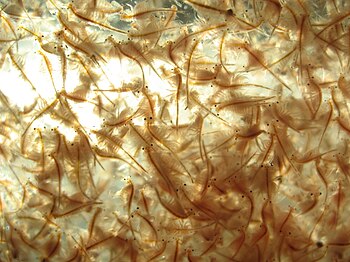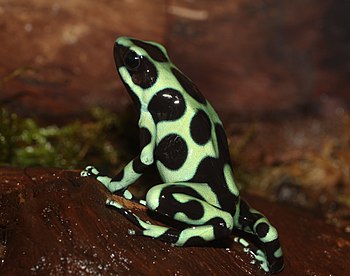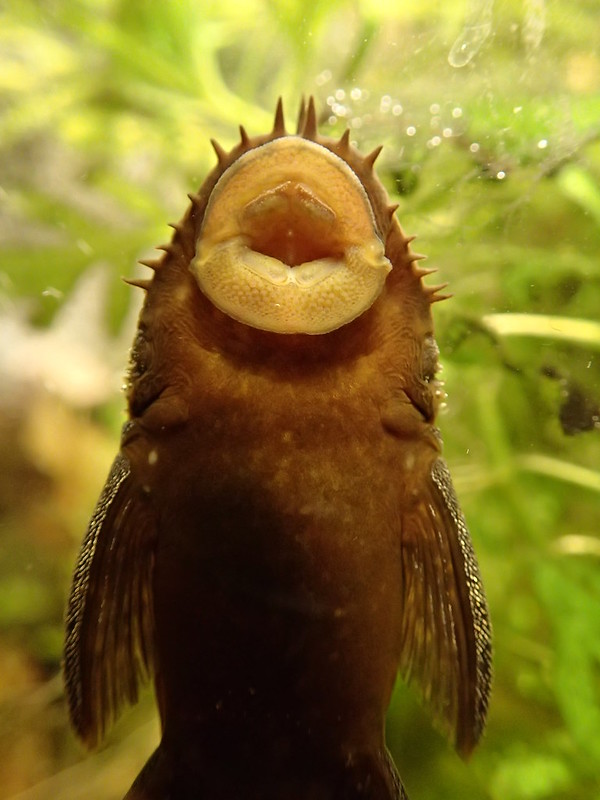Dactylogyrus and Gyrodactylus are monogenean flukes that inhabit the skin, fins and occasionally the gills of freshwater and marine fish. Unlike Lernaea and leeches (other skin-infesting, worm-like parasites of fish), Gyrodactylus and Dactylogyrus are microscopic. Marine monogenetic trematodes on the other hand are large enough to be seen with the naked eye. They attach to fish via a rostral hooked attachment organ. This attachment to the skin causes small puncture wounds in the skin every time the hooks are embedded. The browsing action of the mouth is what causes the damage.
 |
| Common Carp with gill flap birth defect, a good visual example of gills. (Photo credit: Wikipedia) |
Gyrodactylus and Dactylogyrus can be differentiated on the basis of their reproductive methods. Certain fish species like the discus are particularly sensitive to gill fluke infections, where >3 flukes on a 5-10 gill filament biopsy is considered a heavy infestation.
The main difference between the two different flukes is their mode of reproduction and hence the way we manage and treat for the disease. Gyrodactylus are livebearing flukes (i.e. produce live young) and so a single treatment would suffice. Dactylogyrus on the other hand are egg layers and treatments never kill their eggs. Multiple treatments would be necessary to treat dactylogyrosis. Thus it is important to know which you are dealing with.
Clinical Signs
These parasites cause extensive skin and fin damage due to the attachment with their hooks and the feeding activity. Affected fish present with increased mucus production, are usually restless and irritated and may 'flash' or jump out of the water.
Chronic infections causes inappetance which lead to weight loss. The skin often displays epithelial damage which can be complicated by secondary bacterial (usually Aeromonas hydrophila) and fungal infections. The fins are frequently frayed. Although Gyrodactylus is sometimes seen on the gills, it is the Dactylogyrus parasite that is of particular importance here. Known as the 'gill fluke' they cause localised to extensive gill damage and heavy infestations may lead to respiratory incapacity.
Diagnosis
Diagnosis can be made by microscopic observation of these monogenean flukes from skin scrapings or gill biopsies. Even fish that has been dead for several hours can still be examined for the remnants of fluke haptors (in the case of Gyrodactylus). The importance of differentiating the two major types of flukes in freshwater fish is to determine whether multiple treatments are needed (the egg-laying Dactylogyrus will require multiple treatments as the egg stage is refractory to treatment).
Sometimes dactylogyrosis is difficult to detect on wet preparation since distal gill filament clips may miss the organisms - gill flukes have a tendency to inhabit the proximal part of the gills. Sacrificing fish for histology examination will help give you a more conclusive answer.
Treatment
Some commonly used medications effective against monogenetic trematodes include formalin, organophosphates (trichlorfon, fenthion), anthelmintics (praziquantel, fenbendazole), peroxide and osmotic challenge.
This article has been sourced from Loh & Landos (2011) Fish Vetting Essentials, Richmond Loh Publishing, Perth.
Get it now from - http://thefishvet.com.au/shop/shopping.html
--
Now on: Twitter - Blog - Facebook - LinkedIn
--
BSc BVMS MPhil (Vet Path) MANZCVS (Aquatics & Pathobiology) DipPM
Veterinarian / Adjunct Lecturer Murdoch University / Secretary Aquatic Animal Health Chapter ANZCVS
The Fish Vet, Perth, Western Australia. Mobile Veterinary Service for fish and other aquatic creatures.
Ph: +61 (0)421 822 383
Article Source: EzineArticles
|






